Gian Luca Marcialis
Deceptive Beauty: Evaluating the Impact of Beauty Filters on Deepfake and Morphing Attack Detection
Sep 17, 2025Abstract:Digital beautification through social media filters has become increasingly popular, raising concerns about the reliability of facial images and videos and the effectiveness of automated face analysis. This issue is particularly critical for digital manipulation detectors, systems aiming at distinguishing between genuine and manipulated data, especially in cases involving deepfakes and morphing attacks designed to deceive humans and automated facial recognition. This study examines whether beauty filters impact the performance of deepfake and morphing attack detectors. We perform a comprehensive analysis, evaluating multiple state-of-the-art detectors on benchmark datasets before and after applying various smoothing filters. Our findings reveal performance degradation, highlighting vulnerabilities introduced by facial enhancements and underscoring the need for robust detection models resilient to such alterations.
Deep Data Hiding for ICAO-Compliant Face Images: A Survey
Aug 26, 2025Abstract:ICAO-compliant facial images, initially designed for secure biometric passports, are increasingly becoming central to identity verification in a wide range of application contexts, including border control, digital travel credentials, and financial services. While their standardization enables global interoperability, it also facilitates practices such as morphing and deepfakes, which can be exploited for harmful purposes like identity theft and illegal sharing of identity documents. Traditional countermeasures like Presentation Attack Detection (PAD) are limited to real-time capture and offer no post-capture protection. This survey paper investigates digital watermarking and steganography as complementary solutions that embed tamper-evident signals directly into the image, enabling persistent verification without compromising ICAO compliance. We provide the first comprehensive analysis of state-of-the-art techniques to evaluate the potential and drawbacks of the underlying approaches concerning the applications involving ICAO-compliant images and their suitability under standard constraints. We highlight key trade-offs, offering guidance for secure deployment in real-world identity systems.
Exploiting Multiple Representations: 3D Face Biometrics Fusion with Application to Surveillance
Apr 26, 2025



Abstract:3D face reconstruction (3DFR) algorithms are based on specific assumptions tailored to the limits and characteristics of the different application scenarios. In this study, we investigate how multiple state-of-the-art 3DFR algorithms can be used to generate a better representation of subjects, with the final goal of improving the performance of face recognition systems in challenging uncontrolled scenarios. We also explore how different parametric and non-parametric score-level fusion methods can exploit the unique strengths of multiple 3DFR algorithms to enhance biometric recognition robustness. With this goal, we propose a comprehensive analysis of several face recognition systems across diverse conditions, such as varying distances and camera setups, intra-dataset and cross-dataset, to assess the robustness of the proposed ensemble method. The results demonstrate that the distinct information provided by different 3DFR algorithms can alleviate the problem of generalizing over multiple application scenarios. In addition, the present study highlights the potential of advanced fusion strategies to enhance the reliability of 3DFR-based face recognition systems, providing the research community with key insights to exploit them in real-world applications effectively. Although the experiments are carried out in a specific face verification setup, our proposed fusion-based 3DFR methods may be applied to other tasks around face biometrics that are not strictly related to identity recognition.
Fragile Watermarking for Image Certification Using Deep Steganographic Embedding
Apr 18, 2025Abstract:Modern identity verification systems increasingly rely on facial images embedded in biometric documents such as electronic passports. To ensure global interoperability and security, these images must comply with strict standards defined by the International Civil Aviation Organization (ICAO), which specify acquisition, quality, and format requirements. However, once issued, these images may undergo unintentional degradations (e.g., compression, resizing) or malicious manipulations (e.g., morphing) and deceive facial recognition systems. In this study, we explore fragile watermarking, based on deep steganographic embedding as a proactive mechanism to certify the authenticity of ICAO-compliant facial images. By embedding a hidden image within the official photo at the time of issuance, we establish an integrity marker that becomes sensitive to any post-issuance modification. We assess how a range of image manipulations affects the recovered hidden image and show that degradation artifacts can serve as robust forensic cues. Furthermore, we propose a classification framework that analyzes the revealed content to detect and categorize the type of manipulation applied. Our experiments demonstrate high detection accuracy, including cross-method scenarios with multiple deep steganography-based models. These findings support the viability of fragile watermarking via steganographic embedding as a valuable tool for biometric document integrity verification.
Improving fingerprint presentation attack detection by an approach integrated into the personal verification stage
Apr 15, 2025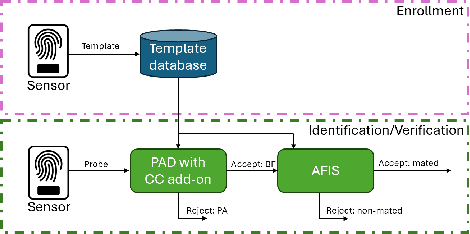
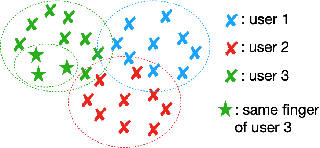
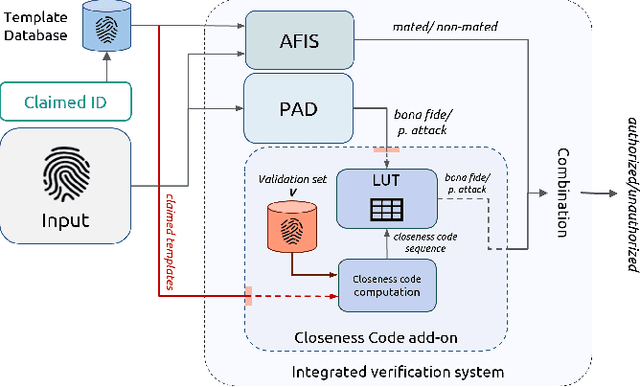
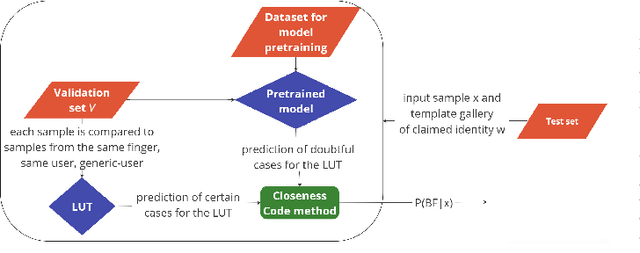
Abstract:Presentation Attack Detection (PAD) systems are usually designed independently of the fingerprint verification system. While this can be acceptable for use cases where specific user templates are not predetermined, it represents a missed opportunity to enhance security in scenarios where integrating PAD with the fingerprint verification system could significantly leverage users' templates, which are the real target of a potential presentation attack. This does not mean that a PAD should be specifically designed for such users; that would imply the availability of many enrolled users' PAI and, consequently, complexity, time, and cost increase. On the contrary, we propose to equip a basic PAD, designed according to the state of the art, with an innovative add-on module called the Closeness Binary Code (CC) module. The term "closeness" refers to a peculiar property of the bona fide-related features: in an Euclidean feature space, genuine fingerprints tend to cluster in a specific pattern. First, samples from the same finger are close to each other, then samples from other fingers of the same user and finally, samples from fingers of other users. This property is statistically verified in our previous publication, and further confirmed in this paper. It is independent of the user population and the feature set class, which can be handcrafted or deep network-based (embeddings). Therefore, the add-on can be designed without the need for the targeted user samples; moreover, it exploits her/his samples' "closeness" property during the verification stage. Extensive experiments on benchmark datasets and state-of-the-art PAD methods confirm the benefits of the proposed add-on, which can be easily coupled with the main PAD module integrated into the fingerprint verification system.
Vulnerabilities in Machine Learning-Based Voice Disorder Detection Systems
Oct 21, 2024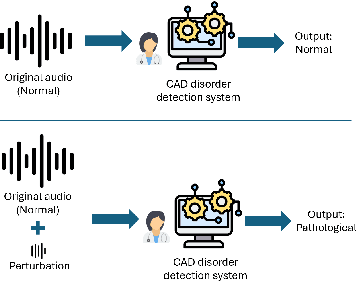
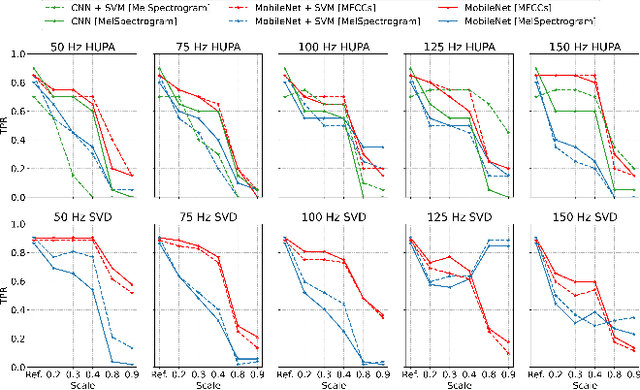
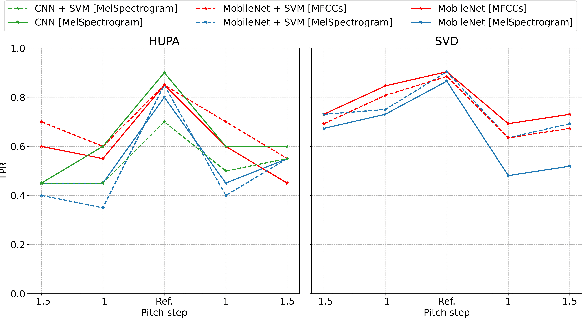
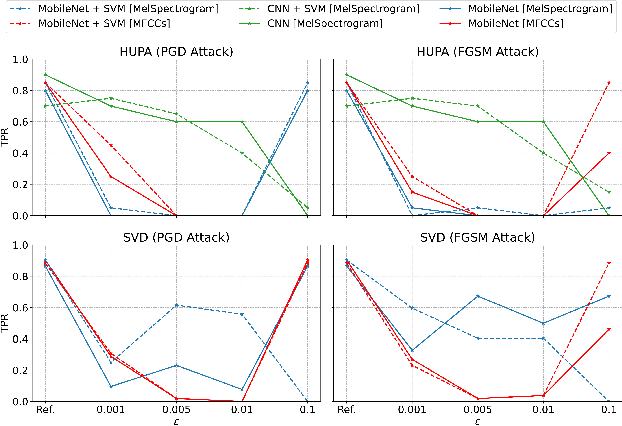
Abstract:The impact of voice disorders is becoming more widely acknowledged as a public health issue. Several machine learning-based classifiers with the potential to identify disorders have been used in recent studies to differentiate between normal and pathological voices and sounds. In this paper, we focus on analyzing the vulnerabilities of these systems by exploring the possibility of attacks that can reverse classification and compromise their reliability. Given the critical nature of personal health information, understanding which types of attacks are effective is a necessary first step toward improving the security of such systems. Starting from the original audios, we implement various attack methods, including adversarial, evasion, and pitching techniques, and evaluate how state-of-the-art disorder detection models respond to them. Our findings identify the most effective attack strategies, underscoring the need to address these vulnerabilities in machine-learning systems used in the healthcare domain.
Exploring 3D Face Reconstruction and Fusion Methods for Face Verification: A Case-Study in Video Surveillance
Sep 16, 2024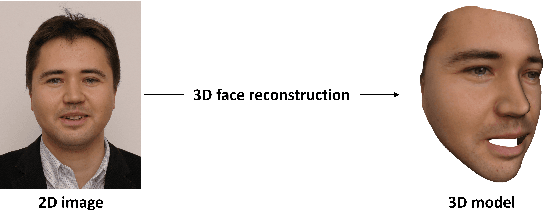

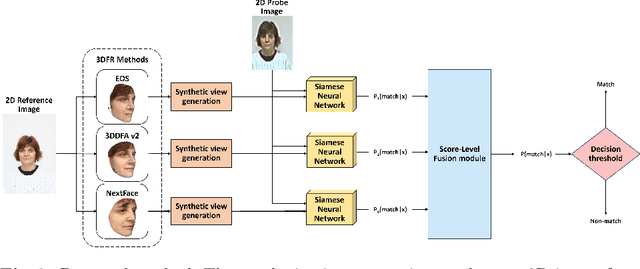

Abstract:3D face reconstruction (3DFR) algorithms are based on specific assumptions tailored to distinct application scenarios. These assumptions limit their use when acquisition conditions, such as the subject's distance from the camera or the camera's characteristics, are different than expected, as typically happens in video surveillance. Additionally, 3DFR algorithms follow various strategies to address the reconstruction of a 3D shape from 2D data, such as statistical model fitting, photometric stereo, or deep learning. In the present study, we explore the application of three 3DFR algorithms representative of the SOTA, employing each one as the template set generator for a face verification system. The scores provided by each system are combined by score-level fusion. We show that the complementarity induced by different 3DFR algorithms improves performance when tests are conducted at never-seen-before distances from the camera and camera characteristics (cross-distance and cross-camera settings), thus encouraging further investigations on multiple 3DFR-based approaches.
Deepfake Media Forensics: State of the Art and Challenges Ahead
Aug 01, 2024Abstract:AI-generated synthetic media, also called Deepfakes, have significantly influenced so many domains, from entertainment to cybersecurity. Generative Adversarial Networks (GANs) and Diffusion Models (DMs) are the main frameworks used to create Deepfakes, producing highly realistic yet fabricated content. While these technologies open up new creative possibilities, they also bring substantial ethical and security risks due to their potential misuse. The rise of such advanced media has led to the development of a cognitive bias known as Impostor Bias, where individuals doubt the authenticity of multimedia due to the awareness of AI's capabilities. As a result, Deepfake detection has become a vital area of research, focusing on identifying subtle inconsistencies and artifacts with machine learning techniques, especially Convolutional Neural Networks (CNNs). Research in forensic Deepfake technology encompasses five main areas: detection, attribution and recognition, passive authentication, detection in realistic scenarios, and active authentication. Each area tackles specific challenges, from tracing the origins of synthetic media and examining its inherent characteristics for authenticity. This paper reviews the primary algorithms that address these challenges, examining their advantages, limitations, and future prospects.
SDFR: Synthetic Data for Face Recognition Competition
Apr 09, 2024



Abstract:Large-scale face recognition datasets are collected by crawling the Internet and without individuals' consent, raising legal, ethical, and privacy concerns. With the recent advances in generative models, recently several works proposed generating synthetic face recognition datasets to mitigate concerns in web-crawled face recognition datasets. This paper presents the summary of the Synthetic Data for Face Recognition (SDFR) Competition held in conjunction with the 18th IEEE International Conference on Automatic Face and Gesture Recognition (FG 2024) and established to investigate the use of synthetic data for training face recognition models. The SDFR competition was split into two tasks, allowing participants to train face recognition systems using new synthetic datasets and/or existing ones. In the first task, the face recognition backbone was fixed and the dataset size was limited, while the second task provided almost complete freedom on the model backbone, the dataset, and the training pipeline. The submitted models were trained on existing and also new synthetic datasets and used clever methods to improve training with synthetic data. The submissions were evaluated and ranked on a diverse set of seven benchmarking datasets. The paper gives an overview of the submitted face recognition models and reports achieved performance compared to baseline models trained on real and synthetic datasets. Furthermore, the evaluation of submissions is extended to bias assessment across different demography groups. Lastly, an outlook on the current state of the research in training face recognition models using synthetic data is presented, and existing problems as well as potential future directions are also discussed.
Serial fusion of multi-modal biometric systems
Jan 24, 2024Abstract:Serial, or sequential, fusion of multiple biometric matchers has been not thoroughly investigated so far. However, this approach exhibits some advantages with respect to the widely adopted parallel approaches. In this paper, we propose a novel theoretical framework for the assessment of performance of such systems, based on a previous work of the authors. Benefits in terms of performance are theoretically evaluated, as well as estimation errors in the model parameters computation. Model is analyzed from the viewpoint of its pros and cons, by mean of preliminary experiments performed on NIST Biometric Score Set 1.
 Add to Chrome
Add to Chrome Add to Firefox
Add to Firefox Add to Edge
Add to Edge